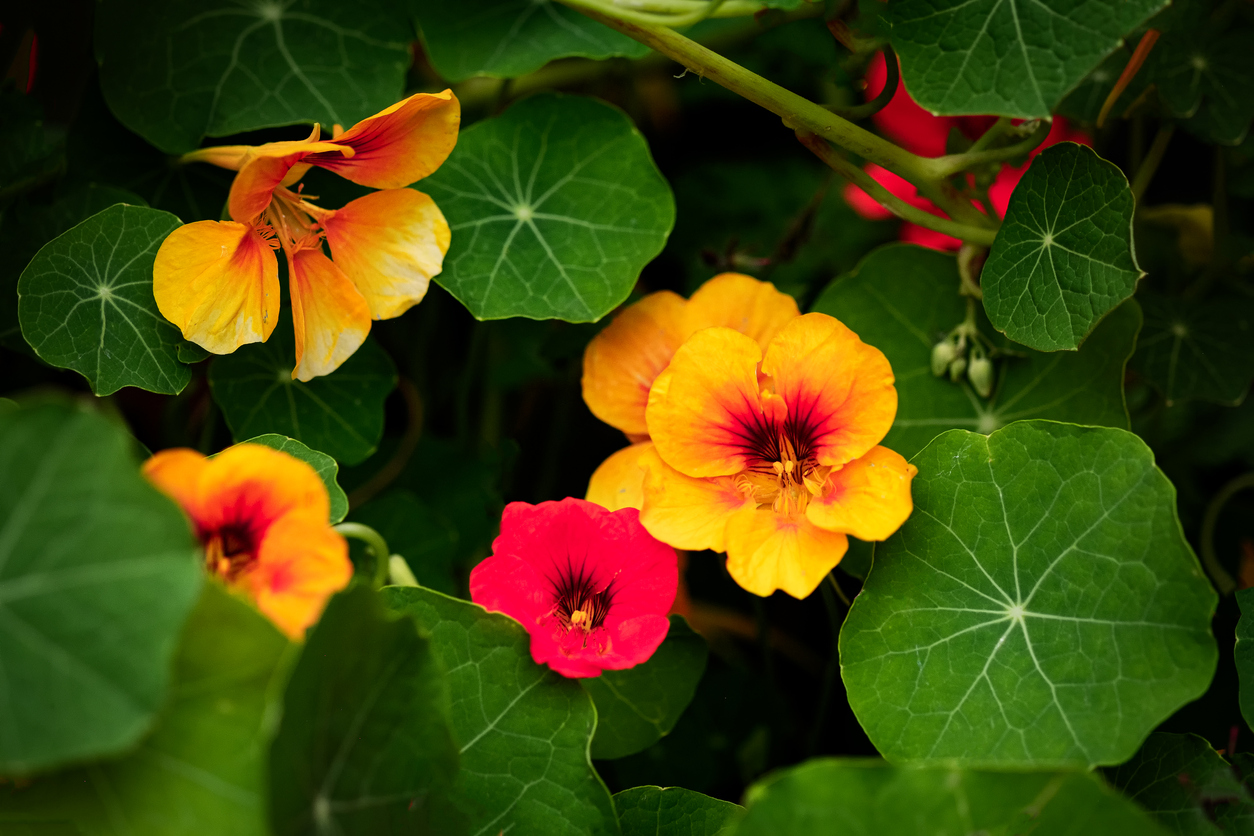Ever wonder why you see so much nasturtium in vegetable gardens? It’s a pretty flower, for sure, but there are plenty of beautiful flowers around. Why don’t you see Irises in vegetable gardens? What about daisies? They’re easy to grow, and they come in so many vibrant colors.
I love a blue iris as much as anybody, but let me tell you, it’s no match for the nasturtium. The nasturtium is a powerhouse in the garden. It benefits your squash, tomatoes, cucumbers, cabbage, and more. They’re hardy little flowers. And yes, they also bring some vibrant color to your garden.
But the nasturtium also has special powers.
Discover 10 top tips for growing, harvesting, and enjoying fruits, vegetables, herbs and more from your home garden—when you access the FREEBIE How to Grow a Vegetable Garden, right now!
The power flower: Why you want nasturtium in vegetable gardens
Before we get to the fabulous flower known as nasturtium, can I just point out that, along with all the benefits that come with having nasturtium in vegetable gardens, there are some pretty tasty reasons for growing it? These brightly-colored edible flowers are packed with vitamin C and lutein. And they taste great – a bit spicy and peppery. They’re perfect in a salad or as a garnish on just about any plate.
As good as they are in the kitchen, the nasturtium is one of the most beneficial companion plants out there. The flower is often considered a sacrificial plant or a trap crop because they “trap” bugs by keeping them off your vegetables. A number of pests, such as aphids, cabbage loopers, and leafhoppers, love to find nasturtium in vegetable gardens. While this isn’t ideal for the nasturtium, it is good for your other vegetables, as they can remain pest-free. There’s still some debate whether these flowers attract pests to your garden too, and I wondered that myself when I had major aphids for the first time after planting marigolds.
But they’re also known to repel pests such as squash bugs, whiteflies, and pumpkin beetles. I should point out that some sources say the plant also repels rather than attracts some pests such as aphids. Like anything in life, little in gardening is 100% one thing or the other.
There’s nothing wrong with taking advantage of the pest-attracting or repelling qualities of the nasturtium, but I prefer the other side of this equation. The flower also attracts pollinators and beneficial insects. Hummingbirds, bees, and butterflies all love the nasturtium, as does the hoverfly, which feeds on aphids.
How to grow and care for nasturtiums
Planting nasturtium in vegetable gardens is a pretty stress-free way to improve your overall garden. They do well in poor soil, are somewhat drought-tolerant, and can grow in containers or directly in the ground. They enjoy the sunshine, but will also grow well in partial shade.
Some vining varieties will grow as much as 15 feet and require a trellis, but plenty of bush varieties will stay more manageable. For either type, you may need to trim them back now and then to encourage more flower production.
In either case, it’s easy to care for nasturtium in vegetable gardens, and the flower brings all sorts of benefits with it.
Have you grown nasturtiums? What was your favorite thing about having them in your garden?
Discover 10 top tips for growing, harvesting, and enjoying fruits, vegetables, herbs and more from your home garden—when you access the FREEBIE How to Grow a Vegetable Garden, right now!

18 replies on “Why and How to Grow Nasturtium in Vegetable Gardens”
Not a comment on nasturtiums, but this has been a banner year for grasshoppers here in SLC, and the seagulls haven’t even made an appearance. The hoppers have taken a very heavy toll on our tomatoes in particular. Any organic suggestions for next year?
Here’s a few things you can try: spray neem oil, spray a solution of vinegar and water, sprinkle diatomaceous earth or sprinkle all-purpose flour.
The ripe buds taste similar to caper berries. I harvest the ripened buds and pickle them to make my own capers.
Well, brine them actually.
They over-ran our raised bed of hot peppers. Had to move the and replant elsewhere. I didn’t find the flowers very tasty.
So interesting! Would like to know more?
I find they have no flavor, just fuzzy
me too
Are you sure you planted nasturtiums?
I grow them along with veges and roses. I love the taste of the young leaves and flowers in salads and sandwiches. Such a lovely splash of bright colour in the garden too.
Do they grow well in very Hot weather or do they prefer cooler less humid weather! I have difficulty with these jewels in Va I use to grow them in Canada and never had a problem there!
I’m having same problem in South Carolina – they just can’t take the hot humid summers down here – easy to grow in Minnesota – miss them!
First time planting them this year. I have them in containers. One of them is getting eaten. Haven’t seen the critter. Just leaves the leaf skeleton and stem behind.
Critters DO like to eat them! Unfortunately, they’re a bit sacrificial as trap crops, to get critters and insects to eat those instead of your veggies!
I’ve always had them- around the garden along with marigolds- but mostly for the pretty bright and attractive factor.
That too! They’re so lovely 🙂
Grew nasturtiums in pots …. We had an iguana and she loved to eat them along with marigolds ….
I guess everybody loves them, ha!